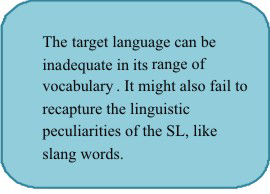Inadequacy of Target Language
The issue of translatability is premised upon the notion that the TL is somehow inadequate to be a suitable vehicle for the ideas, concepts or stylistic nuances of the SL text.  These problems are of different sorts. It could be that the TL is a relatively ancient language and might not have equivalents of new concepts or ideas. For example, all terms that have to do with technological advancement might not have easy translations in most Indian languages. Words like ‘computer' and all terms related to computer usage, scientific terms or words like railways, train, car, bus etc are retained in English in these languages. Even an illiterate person is more familiar with these terms than their Indian versions. This happens because our languages have not kept up with the advancements made in the west. More importantly, the fields of science and technology use English for dissemination of information and hence English is more familiar as far as the users are concerned. These problems are of different sorts. It could be that the TL is a relatively ancient language and might not have equivalents of new concepts or ideas. For example, all terms that have to do with technological advancement might not have easy translations in most Indian languages. Words like ‘computer' and all terms related to computer usage, scientific terms or words like railways, train, car, bus etc are retained in English in these languages. Even an illiterate person is more familiar with these terms than their Indian versions. This happens because our languages have not kept up with the advancements made in the west. More importantly, the fields of science and technology use English for dissemination of information and hence English is more familiar as far as the users are concerned.
Another problem can occur if the SL is usese a particular sub-code. For instance slang usage or dialectical usage of the language is a problem for the translator. The translator of Bernard Shaw's Pygmalion will have to bring out the differences in the language used by Prof. Higgins and Eliza Dolittle. Shaw has used King's English and Cockney for the same. A translator who is doing a Hindi translation will have to be very careful of the sub-code s/he will use. In some cases it cannot be reproduced adequately. This kind of a problem arises when archaic texts are translated. How does one translate Chaucer into Tamil? Chaucer's English is outdated and not in current use. Does it get translated into ancient Tamil which might need explanatory notes for readers to understand it? Translating it into modern Tamil will make it more comprehensible for the readers, but Chaucer's unique language and style will go unnoticed. |